by John Markwell | Contributing Editor
Chronograph Data
Load Velocity fps
CorBon 160gr. DPX 1195
Hornady Critical Duty
220-gr. Flexlock +P 961
Winchester Defend
230 HP 848
Wilson Combat
200-gr. XTP 1013
Federal 230-gr. HS 859
Win. GI 230 Ball 778
Geezer Load
Berry’s 185RNHB/
4.3-gr. Clays Mixed cases/
Win LP primer 772
The evolution of the 1911 Concealed Carry Officers Model pistol is an incomplete yet interesting story. In the ’70s, several American pistolsmiths were cutting down the Colt 1911 Government Model to make it more compact and easy to carry. Charlie Kelsey of Devel, and Austin Behlert, both offered compact conversions of the 1911 as did Armand Swenson and a gentleman named George Sheldon. All these guys shortened grip frames before Colt came out with their Officer’s-sized guns.
In 1976 the “Combat Master” was offered by Detonics. This was also a cut down 1911 with a 3.5” barrel and chopped off grip frame. And, there was also the Star PD. Colt finally caught on and brought out their first reduced size 1911, the Colt Officer’s ACP, around 1985 and others soon followed. The Officer’s ACP had a shortened grip frame, giving up one round in the magazine, and a 3.5 inch barrel.
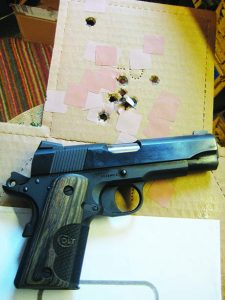
Early in the CCO’s testing with the original stocks in place. 8 rounds of the “Geezer Load” at ten yards.
One thing that all these early compact 1911s had in common was their sketchy reliability. This was due partly to magazine and recoil spring issues related to the higher velocity of the shorter slides due to their reduced weight. The beauty of these custom guns, and Colt’s Officer’s Model ACP was the shortened grip frames which made concealment easier. Barrel and slide length actually contributed little positive to the reduced size concept or ease of concealment.
We could not find out who first put a 4¼-nch Commander slide on an Officer’s-sized frame but we are pretty sure it was either Kelsey or the folks at Colt. However, we could be wrong on this. The gunsmiths at Gunsite Academy offered a Colt CCO for a while through the Pro Shop and Colt has offered both steel and aluminum-framed CCO pistols on and off. Many of the other makers of 1911 pistols also have guns of the CCO configuration in their lines. Dan Wesson, Kimber, S&W, Nighthawk, and Guncrafter Industries all offer 1911 pistols of the CCO configuration. Features differ, and prices run from $800 to around $3500; choose your poison. We agree with gun writers Ray Ordorica and Massad Ayoob that the CCO 1911 pistol concept, which is defined specifically as an Officer’s-sized frame with a Commander length (4¼ inch) slide and barrel, is, quite possibly, the best of the 1911 variations for concealed carry. The CCO offers good concealment with its short grip frame and excellent shootability and reliability due to the Commander top end with its 5¾ inch sight radius and the regular recoil spring set-up. Modern magazine technology has also enhanced the reliability of the CCO concept.
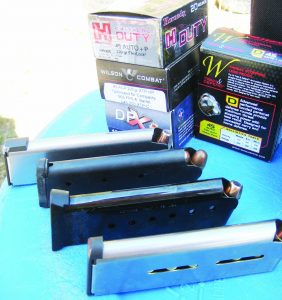
The Wiley Clapp CCO proved reliable with all the ammo and the magazines tested. Wilson Combat 8-round mag (back) and 7-rounder (front). Colt 7-round (2nd from back) and 7-round Nighthawk (#2 from front).
We have been shooting Colt’s newest iteration, the Wiley Clapp CCO in 45ACP, for about five months now as this is writen. Made at the behest of TALO Distributors, this pistol has a Series 70 alloy frame with a beautifully checkered (25LPI) front strap by Pete Single. The pistol has a high cut under the trigger guard and a blended beavertail grip safety allowing for a high grip on the pistol. Both the magazine release and mainspring housing are checkered and the MS housing is rounded off and smooth on the bottom so as to not snag on cover clothing. The magazine well has a pretty good bevel; certainly better than that on the Delta Elite we had a while back. The slide stop is pretty much modern Colt, but the long solid trigger and the small thumb safety are the old original 1911 style; kind of a “retro touch”. The Stocks are a gray wood laminate. They are somewhat thin, but oval shaped, with “finger-tip” checkering and the Colt logo. The slide is roll marked “Commander Model COLT Automatic Caliber 45”. The barrel is 4¼ inches long, nicely throated and crowned, and the barrel bushing is snug but can be turned by hand for disassembly. The recoil spring plug, by the way, is of the GI type with the indent stamped into it so as to be captured by the recoil spring. The ejection port is lowered and flared for positive case ejection and the grasping grooves on the slide are slanted in the National Match style. Lastly, the Novak sights are great! The brass bead front and wide notch rear provide a bold and easily seen sight picture; even for our aging eyes.
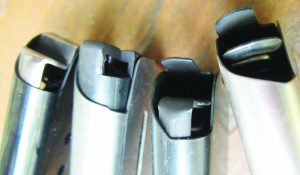
L to R: Nighthawk, Wilson Combat and Colt magazine followers cannot move forward upon last round feeding to impact the CCO’s feed ramp. Far right is an old Colt magazine with a Devel follower that can be moved forward upon feeding the last round.
In shooting the Wiley Clapp CCO we used the two 7-round magazines provided by Colt and from Brownells, (www.brownells.com) we got a Nighthawk Custom 7-round Officers Mag with a nice polymer base pad and a stepped stainless follower. We also obtained two Wilson Combat (www.wilsoncombat.com) mags; a 7-round #470X with a plastic base pad (which we replaced with a steel one) and a slightly extended 8-round #47DX with a steel Lo-Profile base pad that prevents over insertion. Using these modern magazines, the Officer’s ACP frame of the CCO still offers the same cartridge capacity as the original 1911 pistol in 45ACP, 7+1, with a flush fit of the Colt mags to the gun’s butt. The Wilson 8-rounder protrudes about 5/8 of an inch but it is only carried as a spare magazine. A common problem with alloy framed 1911 pistols in the past, has been feed ramp gouging by the forward movement of the magazine follower upon the feeding of the last round (and some say being augered by hollowpoint ammo as well). All the magazines we used had followers that eliminated that forward, last round feed, movement. We had no magazine problems during the shooting of over 750 rounds through the WC CCO. All the mags dropped freely when the mag release was pressed and all seated positively with no undue force required when seating in the gun, even with the slide in battery. Feeding was smooth and positive even for the first and last rounds from all of the mags. The Colt magazines proved to be the hardest to charge up while the Wilsons and the Nighthawk were noticeably easy to fill with ammo.
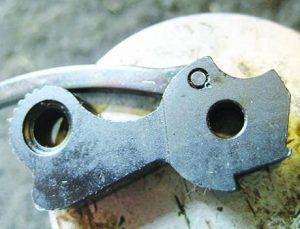
One tap with a punch on each side of the hammer staked the hammer strut pin in place.
On the range the WC CCO was a stellar performer. With nothing more than an application of some lube, the pistol flawlessly digested every load we tried. We were pleased to find that the CCO shot to the top of the front sight at 15 yards with no adjustment for windage being required. When we properly pressed the trigger to the rear, all the loads tested shot well within the “hand rule” at that distance. Although we shot the WC CCO out to 25 yards, most of our shooting was at defensive distances; 15 yards and in. Like shooting a LW Commander, the recoil of the alloy framed CCO was brisk but not objectionable. However, the Wilson Combat 200-gr. XTP load, the Hornady 220-gr. Flexlock +P and the CorBon 160-gr. DPX loads are not to be taken lightly as they are serious defensive loads. Unlike the short barreled 1911s, the 4¼ inch Commander barrel of the CCO gives up very little in velocity; see the attached chart. Most of our shooting was done with our “Geezer load”; a Berry’s 185-gr. HBRN plated bullet at a very mild 772fps. At this point in our life, this is our load of choice for the 45ACP; it’s accurate, reliable in our guns, and easy on the joints.
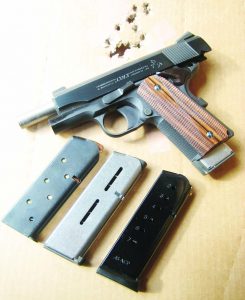
The final product! Macassar Ebony stocks and a Wilson Combat Low Thumb safety are the only mods made to the CCO. Wilson Combat 8-round magazine is in the pistol. Other mags L to R: Colt, Wilson Combat 7 round, Nighthawk 7 round.
We liked the WC CCO pistol well enough that we wrote the Colt folks a check for it. Need had little to do with it. We’ve made a few changes to the pistol since and have a couple of suggestions for Colt as well. We replaced the small thumb safety with a Wilson Combat Bullet Proof Low thumb safety purely because we prefer this unit. Also, we clipped one coil off the spring of the magazine release making it a bit easier to depress. As a cosmetic touch, we replaced the factory stocks with a pair of thin Macassar Ebony double diamond checkered stocks from Craig Spegal. To the Colt folks, we would suggest the addition of either a steel feed ramp insert or a ramped barrel to the WC CCO. Either, we feel, would enhance the durability of the pistol. Also, the hammer strut pin should be staked in place. Upon disassembly of the pistol this pin fell out. It only took us a minute to stake it in place. Lastly, a few of the edges on the WC CCO are pretty sharp; a bit of de-horning would be a nice touch.
The Colt Wiley Clapp CCO has now been incorporated into our battery of daily carry guns. With one of the flush fit Colt magazines and 7+1 rounds of Wilson Combat’s 200-gr. XTP load (and the 8-round Wilson magazine as a spare) the WC CCO inspires confidence. Easily concealed and carried, reliable and accurate, the Wiley Clapp CCO 1911 pistol from Colt is an example of a production gun done right. With many features found only on custom handguns, this is a pistol that is well worth the street price of around $1000. Hopefully the WC CCO will stay in the Colt line for quite some time. We believe that as more folks discover the advantages of CCO configured 1911s demand will soar and many more CCOs will be found in the holsters of armed Americans. If our example is any indicator, Colt has a winner in the Wiley Clapp CCO. Good shooting.



